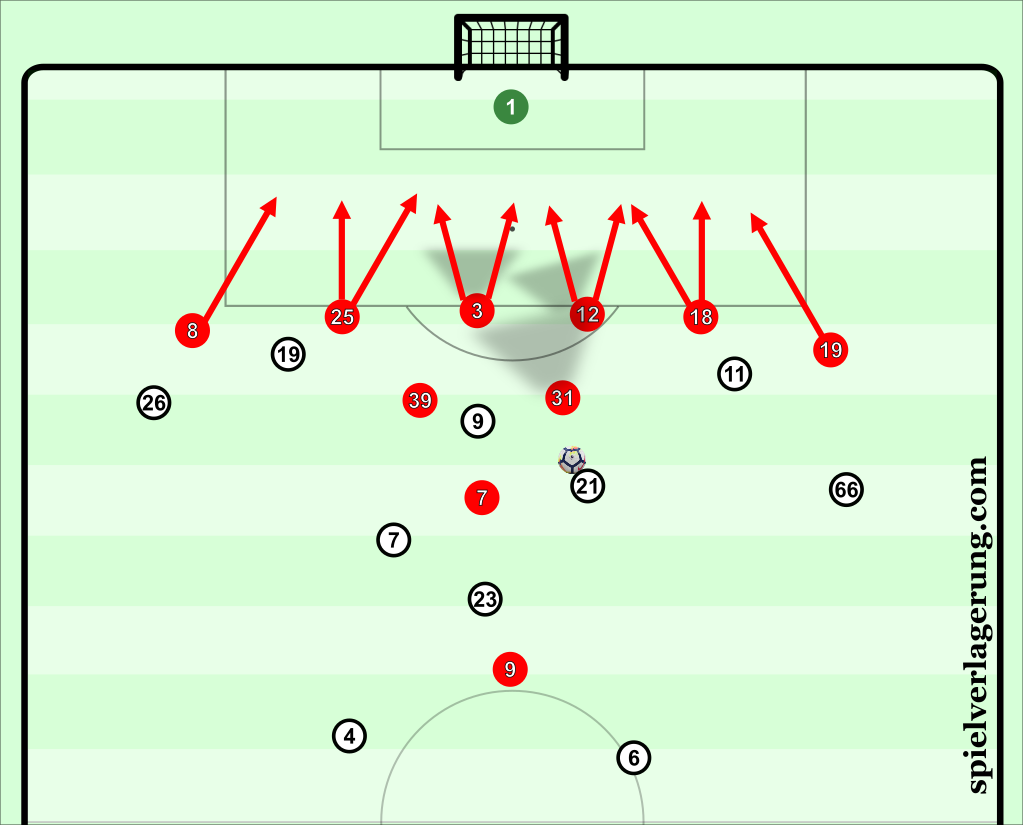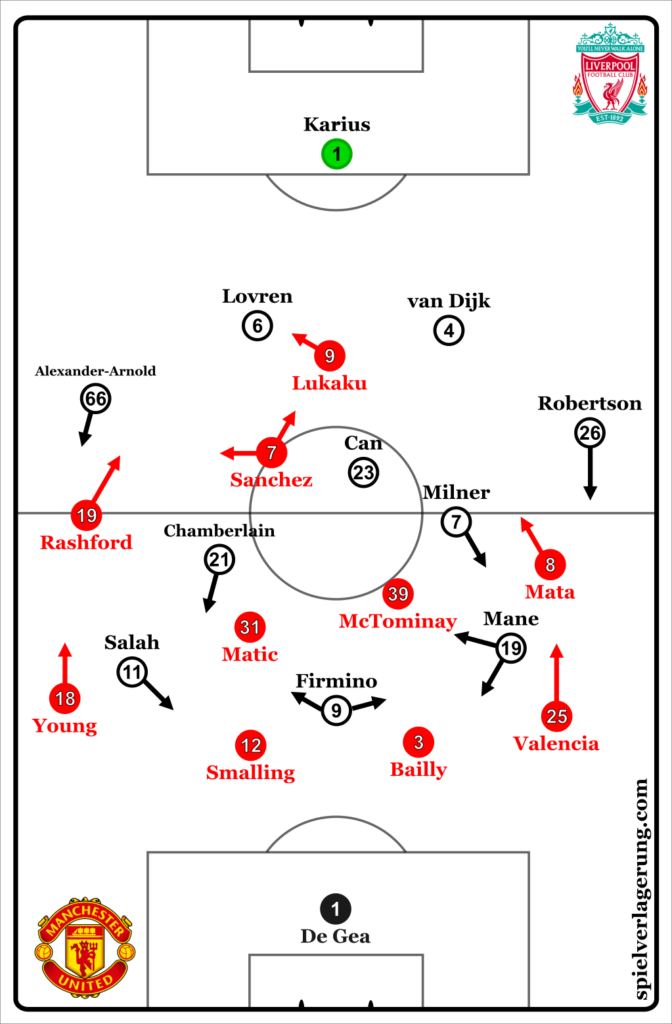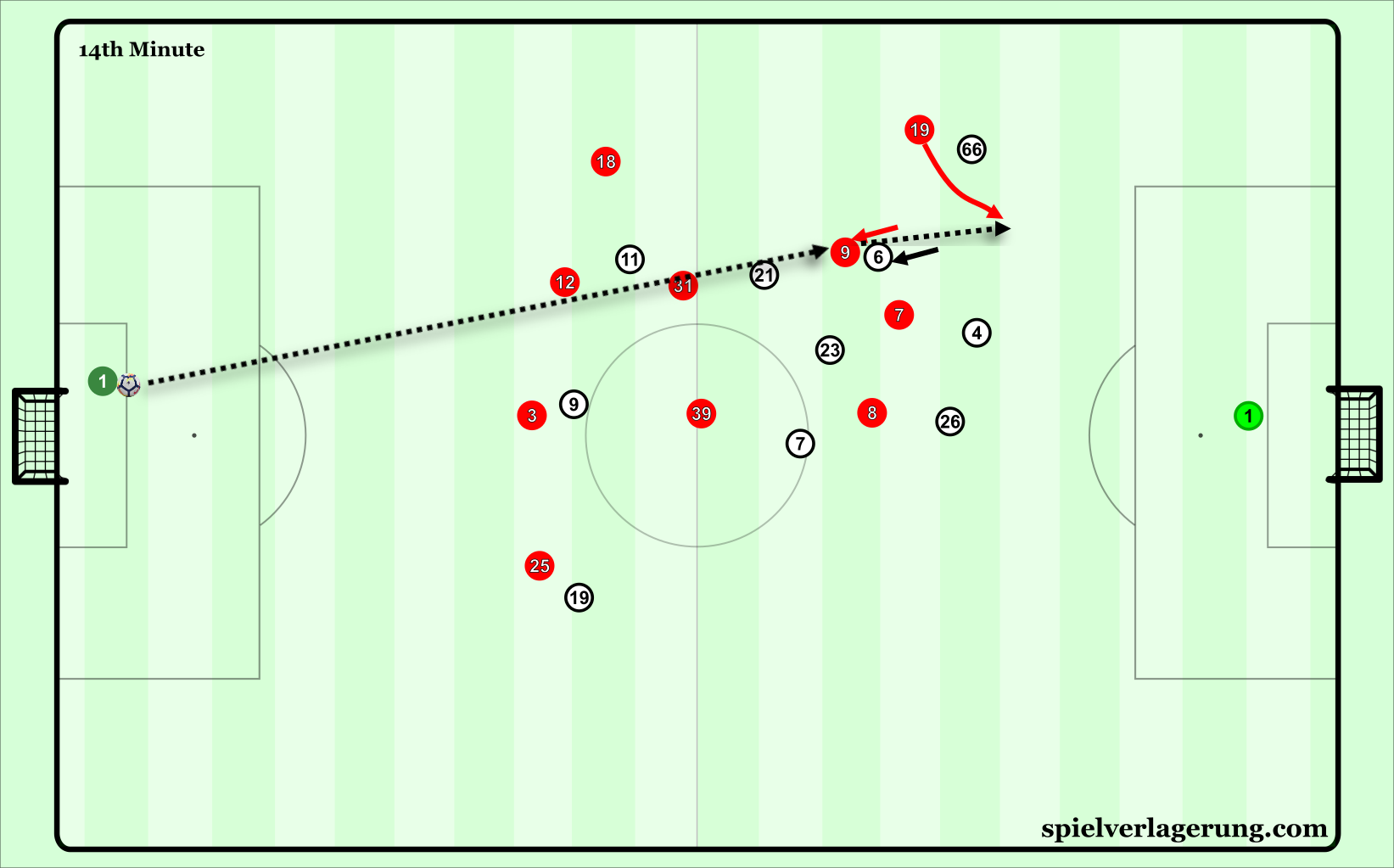For England’s Silver Medal
Manchester United extended their margin ahead of their rivals for second place to five points in a quintessential Jose Mourinho win.
Manchester United were without headliners Paul Pogba and Anthony Martial because of injury, but did not lack the physical qualities that those two bring. Rashford covered for Martial in a nearly like for like swap, while Scott McTominay replaced Pogba. To replenish the industry and creativity in the centre, Alexis Sanchez was moved inside to play as an attacking midfielder. For the away side, their starting team was rather expected. The main notable inclusions were James Milner and Chamberlain, as Klopp preferred to have Wijnaldum on the bench.
Lukaku and his Sidekicks
As in commonplace for Mourinho teams in big matches, Manchester United deferred the bulk of possession to their opponents. With Liverpool aiming to pressure early in the home side’s build up, United bypassed Liverpool’s pressure either through playing long balls up to Lukaku and playing off of him, or by playing side to side around the pressure of the midfield and playing combination football around the flanks.
First, we’ll discuss United’s number 9. Since United have signed the bulky Belgian, their attack has become more direct in terms of the build up approach and solution use. With a physical advantage up front, Manchester United have been more prone to using direct solves as a way to progress forward and as a target for creating chances (this was discussed in Episode 5 of the SV Podcast). Contrary to what may be portrayed, Lukaku was not actively positioned in the left-centre to target Dejan Lovren, a notable weakness in Liverpool’s defensive line this season. Rather, Lukaku would actually spend a fair amount of time in the centre-right being covered by van Dijk or Robertson, partially because of natural interchanging with Sanchez alongside staying central to be targeted for crosses.
Lukaku’s involvement in the goals that propelled United to three points were mainly circumstantial and not purposeful humiliation of Lovren, as he would alternate with Sanchez regarding which side to take for goal-kicks. If anything, the instruction was for De Gea to always target Lukaku from goal-kicks and long distribution, with a more focused effort on the left side of attack to target the youthful Alexander-Arnold. When Lukaku would win the ball, the bolstered numbers around him would increase the probability of winning any flick ons or second balls. Targeting the left side would be a test for Alexander-Arnold, only 19 years of age and hoping to catch him switched off for a brief moment. United got exactly that on the first goal, as Lovren failed to contest Lukaku, who flicked it onto Rashford. The England international was able to easily move past the youngster and score in a spectacular fashion.
A more calculated tactic demonstrated in the match was the movements of the supporting players behind Lukaku. Pardon the pun, but the players on either side the striker were the key sidekicks in engineering efforts in the final third. With Mata coming from the right side to support, the left flank would be overloaded with three players. Some nice sequences would yield from this, with the combination play of Mourinho teams generally overlooked. With Rashford offering direct running in behind, mixing between going inside and outside of Alexander-Arnold, Sanchez and Mata could bait Liverpool to pressure and play just in time to meet Rashford for example.
With these 3v2 opportunities, they exhibited nice dynamic with good understanding of when to move forward into attacking spaces. Thanks to Lukaku’s earlier contributions, both Liverpool centre backs became excessively fixated with him, worried they may lose sight of him for a moment and concede yet again. This worry was counter productive, as they overlooked Mata and Sanchez when they moved forward and almost conceded a third because of it.

United’s 3v2 in on the left caused an overload around Alexander-Arnold, and with the centre backs worried about Lukaku, Mata in this case is able to move forward undetected.
From Liverpool’s perspective, Klopp could’ve increased pressure onto David De Gea for long passes (such as on the second goal) once it was evident that he would function as a source of distribution. Perhaps he didn’t want United to have the ball in case they decided to build out in response to Firmino pressing high for example, expecting a direct game and preparing for second balls accordingly by enlisting numbers.
Mourinho’s Famous 6-3-1
Against the ball, United’s wingers dropped back into the defensive line to track the opposition fullbacks, forming the well-renowned 6-3-1 low block that gets criticized often by some. Defending deep does not exercise a high degree of control when it comes to both spatial dynamics and with the ball. However, Mourinho has a preference of forcing his opponents to break his team down in front of them, rather than commit his team higher up and risk exposing spaces behind his defense. Since Mourinho defers possession, the onus is on Liverpool’s players to be the playmakers rather than their pressing.
This tactic has a history of costing Mourinho in the end during big matches. However, specifically against Liverpool, the low block had some theoretical merits that made it a sound option to use.
- Limiting space for Mane and Salah to run in behind
Due to the starting position of the 6-3-1 in a low block, Liverpool’s largest goalscoring threats are restricted to less space to run in behind the defense and penetrate. As a result, there is a significantly smaller margin of error when it comes to the timing and quality of both penetrating passes and runs. Any passes that are too hard, it goes to the goalkeeper and passes that are too short can be dealt with or cleared. Runs that are too early are offside and too late don’t end up finding feet. Rather than have these finer details of attacking play be corrected by Salah and Mane’s speed over a larger distance, that factor is gone with the positioning of the deep block.
- Added central numbers in the penalty area to deal with last ditch situations.
With the wingers dropping back to defend, this allows the fullbacks to tuck inside and occupy more central positions. So, for the moments in which Liverpool are in the penalty area, it is quicker for players to surround the player with the ball and prevent him from scoring. With skillful dribblers like Firmino and Salah in the team, these defensive reinforcements serve to block their influence on the scoresheet.
- Shield for De Gea on long shots
By a similar token, by having so many numbers in front of the goal, there are more intermediates that have to be passed in order to get to the goalkeeper. In United’s case, having three of four players in front of the ball increases the likelihood that the shot gets blocked or has the juice taken off it through a deflection. From De Gea’s point of view, this can provide comfort in knowing that you may not have to make difficult saves from shots outside the penalty area, since the defense will attempt to block them.
Liverpool is littered with options who can score from distance, so having the long physiques of Matic and McTominay enlisted to prevent shots is one way that Liverpool’s danger can be temporarily extinguished. However, deflections can also wrong foot the goalkeeper and lead to unlikely goals. In addition, more players in front of the goal can block the goalkeeper’s vision of the ball, so this is a double edged sword.

United’s back 6 can easily move to cover last ditch situations in the penalty area, while also blocking off the goal for De Gea if shots are taken from distance.
Another component to United’s defensive play was their possession, an unusual trait for Mourinho teams during big matches where they have a lead. After going 2 up, most of possession was used for consolidation and game management. In it, their possession often seemed devoid of any direction and instead aimed to wind down the clock once they reached half way. Plus, their creative players would also look to draw fouls when they dribbled up, a dual purpose way of taking off time and moving the rest of the team up. This would release pressure from the defenders until the next barrage of Liverpool attacks. I outlined other specifics of this in the twitter thread below:
https://twitter.com/AReynolds70/status/972482588819501057
https://twitter.com/AReynolds70/status/972482592678318080
Liverpool’s Attacking Struggles and Adjustments
The attack from the visitors was slightly different than normal, both in terms of behavior and execution. For example, Sadio Mane would drift in front of Milner and Chamberlain at the top of a diamond, rather than wider to run inside in the attacking third of the pitch. Combined with Firmino’s movements in front of the centre backs, and there was little threatening activity for United’s defense to deal with since there was nothing that endangered them in front. Liverpool often failed to protect the ball because of being outnumbered locally, alongside a handful of sloppy technical mistakes.
Due to the central congestion, most of the attacking momentum generated from Liverpool was in wide zones. Firmino took his runs away from goal for instance, hoping to have supplementary options in the penalty area to meet his distribution centrally. Runs in behind were not made with the same frequency as usual, but United tracked the runs and dealt with any uncertainty by playing the ball out of bounds, oftentimes for a corner kick. Liverpool’s first half display did featured several counter attacks where they were needlessly direct, deciding to play options higher up the pitch that were handsomely covered instead of more dynamic options running into larger areas that had potential. The first half was an off display as reflected in the poor choices and execution in attack.
Adjustments
In the second half, Liverpool’s overall intensity in attack improved greatly. The most notable adjustment was the positioning of the fullbacks and the central midfielders. Both fullbacks began to occupy higher positions, and Chamberlain also began to play closer to the forwards, pinning United further back closer to their goal. With the former Arsenal man higher up, the away side registered some central combination play to unlock Manchester United. Adam Lallana was brought on for him to add creativity against a now retreated United team. Eric Bailly was proactive in his timing to step up to halt these attacks that were focused down the middle, the most impressive defensive performance on the day.
With more dynamic movements on the wings, Liverpool began to focus more on early deliveries of their low crossing across the deep block. This would be successful provided that the crosses where played in the gap between the goalkeeper and behind the defensive line. As attackers run toward the ball, defenders are running toward their own goal and simultaneously trying to track the ball and the nearest player. Due to this awkward orientation, they can easily lose sight of their players for a fraction of a second (enough to create separation), or be in a bad body shape to deal with the cross, possibly leading to an own goal in the worst case (seen with Bailly in minute 65).
Liverpool continued to pile on the pressure from width for the remainder of the match. After Fellaini was introduced into the match, United allocated their attention to preventing getting beat on aerial duels that Liverpool were creating. The theoretical components mentioned earlier in United’s deep block were manifested, with consistent efforts to block Liverpool’s shots of all types rather than have De Gea bail them out. Manchester United managed to survive the barrage of possession and conceded territory that Liverpool seized. Klopp’s team however did not capitalize and De Gea left the match without having to stand on his head to keep his team in the lead.
Conclusion
The level of this match wasn’t remarkably high, as Klopp’s team weren’t coerced into playing poorly by the tactics of Mourinho. Thanks to Marcus Rashford’s clinical display in front of goal, Mourinho was able to exercise his version of control over the match. This version of control doesn’t actually do all that much to “control” the game, instead stifling the opponent into being less effective than normal. Still, Liverpool in the second half were quite close to finding a second, with United owing a debt of gratitude to Eric Bailly. In another day where the front three are more effective and less so from Rashford, the narrative on Mourinho shifts from “pragmatic genius” to “cowardly in big matches”.
The title is more a reference to the atmosphere surrounding the match. While a match between these two clubs always is important when it comes to the history of the fixture, this game was lacking a special feeling of possible title implications that normally precede it. It is of course entirely possible that United lose to City and drop other points, giving room for Klopp to rise into second place. For now, the red-half of Manchester looks the most probable for second place.




1 Kommentar Alle anzeigen
Adriel March 12, 2018 um 5:02 pm
What would u make of Sanchez’s performance? I think he was much tactically disciplined, in the past he will start to press unnecessarily causing the shape to be lost.
Although he should have done better in finding Rashford in the second half, I felt that he had a decent game adhering to the game plan itself.